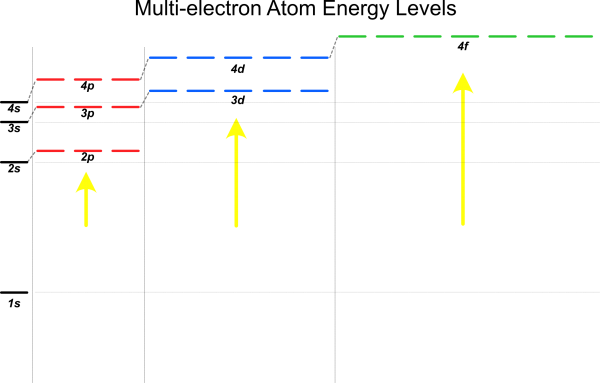Ch7 Lec6
(4/28/20, bes)
Greetings,
- I wanted to post this last lecture well before exam 3 (Friday, May 1st) so that you do not feel too rushed...review these notes as time permits. This is the last lecture for Chapter 7.
Multi-electron Energy Levels
The figure above was presented in yesterday's notes...building upon this...please notice:
- The shift in the energy levels mixes up the order in which the orbitals are filled.
- - the 3d orbitals are now above the 4s orbitals
- - the 4d orbitals are now above the 5s orbitals (not shown in figure)
- - the 5d orbitals are now above the 6s orbitals (not shown in figure)
Filling electrons into orbitals
For boron (B) (as previously discussed), it contains 5 electrons...with 2 electrons per orbital, then the electron configuration is: 1s2 2s2 2p1.
- (Note: in WA i would ask that you enter the answer as, 1s2 2s2 2p1 <-- no superscripts).
For carbon (C) (as previously discussed), it contains 6 electrons...with 2 electrons per orbital, then the electron configuration is: 1s2 2s2 2p2.
- (Note: in WA i would ask that you enter the answer as, 1s2 2s2 2p2 <-- no superscripts).
For neon (Ne), it contains 10 electrons...with 2 electrons per orbital, then the electron configuration is: 1s2 2s2 2p6.
- (Note: in WA i would ask that you enter the answer as, 1s2 2s2 2p6 <-- no superscripts).
For argon (Ar), it contains 18 electrons...with 2 electrons per orbital, then the electron configuration is: 1s2 2s2 2p6 3s2 3p6.
- (Note: in WA i would ask that you enter the answer as, 1s2 2s2 2p6 3s2 3p6 <-- no superscripts).
**things get a bit different at this point...as stated the 3d orbitals shifted up in energy, so we fill the 4s orbitals before we fill the 3d orbitals
For calcium (Ca), it contains 20 electrons...with 2 electrons per orbital, then the electron configuration is: 1s2 2s2 2p6 3s2 3p6 4s2.
- (Note: in WA i would ask that you enter the answer as, 1s2 2s2 2p6 3s2 3p6 4s2).
For scandium (Sc) - the first "transition metal", it contains 21 electrons...with 2 electrons per orbital, then the electron configuration is: 1s2 2s2 2p6 3s2 3p6 4s2 3d1.
- (Note: in WA i would ask that you enter the answer as, 1s2 2s2 2p6 3s2 3p6 4s2 3d1).
The Build-Up Principle
Electron configuration can be summaries in the following version of the periodic table:
1s --> 2s --> 2p --> 3s --> 3p --> 4s --> 3d --> 4p --> 5s --> 4d --> 5p --> 6s --> 4f --> 5d --> 6p --> 7s --> 5f --> 6d --> 7p
Often times the f-orbitals are left out of the periodic table, since it just makes it too long...and does not print out well on the inside cover of your textbook!
The real periodic table can look like this:



